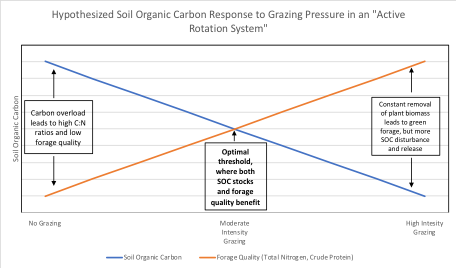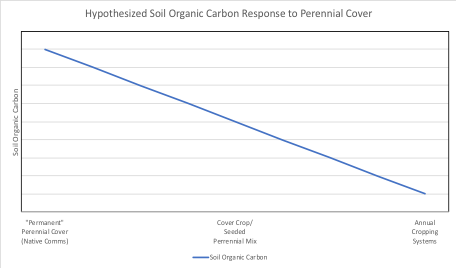Project Overview
Commodities
- Agronomic: grass (misc. perennial), hay, medics/alfalfa, oats, triticale, wheat
- Vegetables: lentils
- Animals: bovine
Practices
- Animal Production: feed/forage, grazing management, grazing - continuous, grazing - rotational, pasture renovation, pasture fertility, range improvement, rangeland/pasture management, stocking rate, winter forage
Proposal abstract:
In the agricultural American west, rangelands provide a multitude of ecosystem services and an economic base supporting rural communities. Resilience of these ecosystems depends on the maintenance and improvement of soil function and biodiversity; however, few studies address the foundational, ranch-scale interactions between soil and plants as a function of landscape position and grazing pressures (Teague et al., 2013). We propose to conduct case studies linking the distribution of soil organic carbon (SOC) with measures of biodiversity and forage quality as a function of management practices on two ranches in diverse parts of Montana that are linked by long-term ownership (Figure 1), framing SOC stocks, biodiversity, and forage quality as measurements of ecosystem health. We propose to undertake these studies in close collaboration with Natural Resources Conservation Service (NRCS) rangeland conservationists alongside producers with over 50 years of management experience. Thus, our study is designed to ensure results that are informed by a systems-based understanding of the landscape and align well with WSARE’s Research and Education Logic Model by improving sustainable agriculture through ranch-scale problem solving.
SOC has been positively associated with many benefits, such as soil stability, water retention, productivity, and positive efficiency response to fertilizer inputs (Van Groenigen et al., 2003; Lal, 2006). Sites lacking biodiversity often lose ecosystem functions and fall victim to invasive species in the face of climatic shifts (Steudel et al., 2012; Isbell et al., 2018). If SOC is indicative of the legacy of ranch management that, in turn, drives biodiversity, can we use measures of SOC as indication of resilient, diverse plant communities by focusing our efforts towards achieving and sustaining SOC stocks through site-specific adaptive management? We suspect that understanding SOC across gradients of perennial cover and grazing intensity will help provide management recommendations for producers that promote sustainability and resiliency.
Project objectives from proposal:
To address our central goal, we identify three key objectives:
Objective 1. Evaluate soil-water-plant interactions: We aim to characterize the range of interactions that SOC and water status has with plant community trends and forage production within the scale of a ranch operation by utilizing statistical models to correlate SOC to biodiversity, primary production, and forage quality.
Prediction 1: SOC stocks will increase with available water, primary production, biodiversity, and litter cover. In turn, we will observe higher forage quality in catchment areas (topographic driver of SOC), and soils with higher capacity for water retention (substrate driver of SOC). These areas, such as lowlands where wind-scoured litter has been caught and incorporated, will foster larger SOC stocks, and lower C:N ratios than sloped topography and well-drained areas.
Objective 2. Characterize grazing intensity: We aim to quantify the degree to which grazing intensity controls SOC and biodiversity. By plotting SOC and biodiversity across continuous gradients of grazing intensity and perennial cover, we can provide evidence for or against management effects on soil and plant health.
Prediction 2: SOC stocks will decrease with removal of perennial native species (Figure 2a). Due to grasslands’ evolution under ungulate grazing, we will observe an “optimal threshold” of SOC, rooting depth, and forage quality in response to moderate grazing intensity. (Figure 2b).
Objective 3. Provide resources for producers: We aim to improve soil health understanding through a working group initiated by the research team and including community members in both Dawson and Blaine Counties. Various educational resources, such as a project website and newsletters circulated to producers regarding sustainable agriculture, will provide additional outreach and resources. We believe providing outlets for producers to converse about sustainable agriculture will help promote producer involvement in conservation efforts and develop a sense of camaraderie between researchers, producers, and agents.

